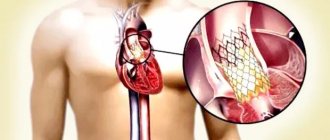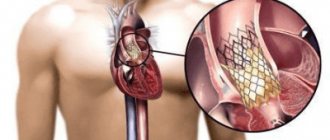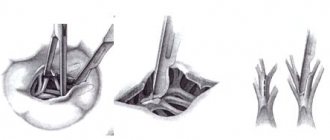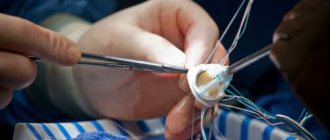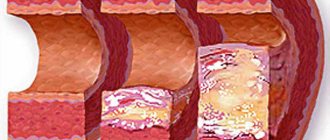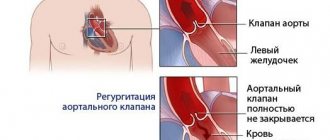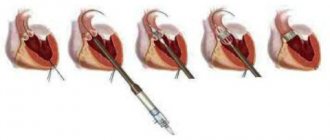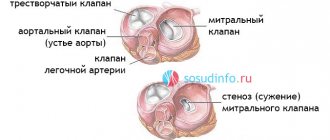Transcatheter aortic valve replacement (TAVI) is a minimally invasive surgical procedure that replaces a heart valve.
The most common pathology of the valve apparatus is aortic stenosis . The disease is treated only with surgical methods.
According to statistics, classical surgery using artificial circulation for 11-15% of patients in the older age group with concomitant diseases is associated with a high risk of hospital mortality. For this reason, 33% of patients with aortic stenosis are denied classical surgery involving aortic valve replacement.
An alternative surgical method is the TAVI procedure. Implantation of a bioprosthetic aortic valve is carried out on a beating heart. A special catheter is inserted through the femoral artery to deliver and implant a replacement aortic valve.
Symptoms of aortic stenosis
Patients with aortic stenosis exhibit the following general clinical signs:
- headache;
- increase or decrease in blood pressure;
- bradycardia (heart rate less than 60 beats per minute);
- pale skin.
When examining a patient, the doctor additionally discovers:
- “trembling” of the chest, resulting from the passage of blood through the narrowed opening of the valve;
- wheezing in the lungs;
- When listening, it detects faint sounds of valve flaps closing, accompanied by additional noise.
Depending on the degree of narrowing of the aortic mouth, other symptoms may appear:
- dyspnea;
- increased fatigue during physical activity;
- dizziness;
- fainting;
- attacks of suffocation;
- swelling of the lower extremities;
- ascites;
- pain in the right hypochondrium that occurs against the background of an enlarged liver due to blood stagnation.
The fifth degree of aortic stenosis is accompanied by severe shortness of breath, edema of the whole body and acrocyanosis.
Implantation of a bioprosthetic aortic valve through TAVI is indicated for patients with degree 2 or 3 aortic stenosis.
Postoperative period
The recovery period is the most important stage, which has its own characteristics. For the first time after replacing the valve, physical activity and strong psychological experiences are prohibited. Caution must be exercised for at least three years after the intervention. Professional athletes can return to full training only after six years. Taking anticoagulants prescribed by a doctor is a must. It is also very important to regularly check the condition of the body and monitor for possible concomitant pathologies.
In fact, the valve itself will not affect the patient's future health in any way. If irreversible changes have occurred, the patient needs constant monitoring by a cardiologist.
Diagnosis of aortic stenosis before TAVI
The following diagnostic measures can help determine aortic stenosis in a patient:
- electrocardiogram (arrhythmia, blockades are determined);
- exercise electrocardiogram;
- radiography (the expansion of the aortic section located above the stenotic area is visualized, an enlargement of the left ventricle of the heart is detected, and calcification of the orifice is determined);
- echocardiography (an increase in size and thickening of the walls of the aortic valve is visualized, left ventricular hypertrophy is established);
- Doppler echocardiography;
- catheterization of cardiac chambers;
- coronary angiography.
Causes of aortic valve disease
There are many pathological conditions that over time can lead to degenerative changes, calcium deposition on the aortic valve leaflets, and changes in its function.
The human heart is able to compensate for poor circulation for some time. Sooner or later, clinical manifestations occur: dizziness, shortness of breath, fainting, palpitations, angina syndrome. Conservatively (with the help of medications) it is possible to partially compensate for the patient’s condition, but it will not change it radically and will not improve the quality of life.
TAVI procedure
When diagnosing aortic stenosis, doctors prescribe conservative treatment, which includes taking the following medications:
- diuretics that remove excess fluid from the body, reducing the load on the heart;
- dopaminergic agents that activate muscle contractions;
- vasodilating drugs that relieve heart pain;
- antibacterial drugs prescribed for the prevention of endocarditis.
However, the most effective and gentle way to treat aortic stenosis is the TAVI procedure.
Compared to the standard open-heart valve replacement procedure, which requires a sternotomy (opening up the chest), the TAVI procedure can be performed through small punctures in the chest without the need to break the integrity of the chest bones. The surgeon, taking into account the individual characteristics of the patient, determines which approach will be most acceptable and safe for the client:
- transfemoral (catheter is inserted through the femoral artery);
- transapical (the catheter is inserted through a large artery in the chest or the apex of the left ventricle, accessed through a small incision in the chest).
Using a catheter, the disassembled replacement valve is delivered to the installation site, the new valve expands, pushes the leaves of the old valve apart and subsequently takes on the functions of regulating blood flow.
What types of valves are there?
Three types of elements can be used to replace an unhealthy valve:
- Biological. They suggest recreating a new valve from the patient’s own tissues. Such a valve will last about 10-15 years, after which the operation will need to be repeated. This is due to the gradual wear and tear of the element and its inevitable degenerative changes. With this approach, anticoagulants need to be taken only for the first six months after surgery.
- Mechanical. Such a valve is manufactured in a laboratory and requires constant use of anticoagulants (for the entire life of the patient). Such prostheses are installed mainly in patients who have not reached old age.
- Donor. This option is used only in extreme cases, as there is a risk of rejection of donor tissue by the patient's body. The outcome of such an operation is difficult to predict, and the possibility of complications cannot be excluded. In order for the valve to take root, doctors need to carry out therapy that suppresses the recipient’s immunity so that the immune system does not begin to fight the foreign element. As with the installation of an artificial valve, the patient is advised to take lifelong anticoagulants to exclude the possibility of thrombus formation.
- Available: doctor’s appointment from 1500 rubles
- Convenient: open daily from 8:00 to 21:00
- Quickly: we will carry out all the diagnostics at the first appointment
- Complete: has all the necessary equipment
Where to get treatment
collaborates with the National Medical Research Center of Cardiology, which is an expert center for aortic valve replacement in the Russian Federation with experience of more than 1000 implantations.
The clinic is equipped with the latest equipment and software of the latest generation (such as intracardiac and intravascular navigation systems), which allow achieving maximum treatment results with minimal risks of complications. The specialists of our clinic are world-class experts in the field of transcatheter treatment of the heart valve apparatus, who perform TIAC procedures both in the Russian Federation and abroad.
What are the advantages of transcatheter aortic valve implantation over open surgery?
With intravascular aortic valve replacement, there are no large incisions, which significantly reduces the duration of postoperative rehabilitation, reduces pain and eliminates the development of complications associated with inflammation (suppuration) of postoperative sutures. Other important advantages of TAVI include:
- Ability to perform surgery on patients at high surgical risk, elderly patients and patients with severe comorbidities
- Short operation time, reduced surgical trauma.
- The operation is performed under local anesthesia (in some cases under general anesthesia)
- There is no need to connect to a heart-lung machine and “turn off” the patient’s heart
- Reducing length of stay in hospital
- Low percentage of postoperative complications and rapid adaptation after discharge from hospital
About the purpose of disability and prognosis
Non-working group II is determined for a period of one year after completion of the operation to restore the myocardium. In the future, transfer to group 3 is possible.
When establishing disability, cognitive deviations (decreased mental abilities) are taken into account individually.
How long do you live with an artificial valve? The average life expectancy in this case is approximately 20 years. However, theoretically, the valve’s lifespan is much longer (up to 300 years, according to doctors).
Only at high operational risk
“At present, only patients with a clearly increased surgical risk or contraindications to conventional surgery should be considered for interventional cardiology [referring to TAVI], since long-term results are not yet available and high-quality results have not yet been achieved after surgical cardiac replacement. valve (mortality rate of about 3%) or surgical repair of the heart valve (mortality rate of about 2.5%),” the congressional document states.
However, this rule is often ignored, because Many TAVI interventions are performed at significantly lower risk and therefore in younger patients. This is confirmed by statistics from the DGTHG (Association of German Thoracic and Cardiovascular Surgeons) 2010, which were presented by Prof. Mohr, Director of the Cardiac Surgery Clinic, Heart Center in Leipzig.
In addition, the figures confirm the limits of the use of TAVI, since - as pointed out by Prof. Mortality – in patients without a clearly increased risk (Figs. 3 and 4), in-hospital mortality with surgical aortic valve replacement is clearly lower than with TAVI. Even in the group with a clearly increased risk (log EuroSCORE of 20% or more), it is not higher than with TAVI (11.7 and 11.4%, respectively). Also, when distributing patients by age (Fig. 5 and 6), according to the DGTHG graph, up to 85 years of age, there are no noticeable advantages of TAVI compared to surgery, explained Prof. Mor.
In addition, during the discussion it was noted that log. EuroSCORE is not sufficient to evaluate both methods.
Meanwhile, the results of two large studies on TAVI (PARTNER) were published. The PARTNER I study showed that in patients with aortic valve stenosis who are contraindicated for surgery, TAVI is preferable to conservative treatment. The PARTNER II trial showed that in patients with high-risk aortic valve stenosis, TAVI was noninferior to open valve replacement surgery. However, to date, patients have been followed up for an average of only one year, i.e. It is unknown what the long-term results of these methods are in comparison with each other.
Experts have warned about the high potential for abuse of TAVI . Patients with log. A EuroSCORE greater than 20% and those over 75 years of age should not automatically be considered candidates for TAVI.
The figures demonstrate in-hospital mortality after catheter-based TAVI aortic valve implantation on the left (Figs 3+5) and after standard surgery on the right (Figs 4+6) in 2010. The results are presented depending on the age group, etc. "log. EuroSCORE". Log. EuroSCORE shows predicted operative mortality and is calculated based on individual comorbidities and risk factors (eg age, diabetes, renal failure, hypertension...).
Patients with log. have a very high risk. EuroSCORE is above 15-20. Previous experience shows that EuroSCORE actually overestimates operative mortality by 2-3 times, but largely determines the long-term prognosis of the patient. It is clear that younger patients with a low EuroSCORE have excellent outcomes after surgery, while TAVI patients in the younger age groups with a low Euroscore have an unexpectedly high mortality rate. (Prof., MD Friedrich-Wilhelm Mohr, Leipzig)
Role of external cardiologists
The congressional document describes it as “perfectly acceptable” for outside trained cardiologists to perform heart valve implantations on their patients as visiting physicians at the center, in collaboration with the cardiac surgeons and cardiologists employed there. Responsibility and management of the intervention rests with the center’s team of internal cardiologists and cardiac surgeons.”
This controversial piece of Congress has already been discussed. In Frankfurt, experts were unanimous that it is in principle possible to perform TAVI by external cardiologists together with a cardiac surgeon and a cardiologist at the center. But the center's cardiologist must be informed about this in advance so that he can make an independent decision whether he will carry out the intervention together. However, the issue of the responsibility of external cardiologists when working together is not clear. Although the immediate responsibility for the intervention lies with the cardiologist who performs the intervention, responsibility does not end with the completion of the intervention. For example, the clinic is responsible for quality assurance. In addition, the question remains open of who is responsible in the event of complications that arise only a few days after the intervention.
Prognosis after surgery
Transcatheter aortic valve replacement with a bioprosthesis is better tolerated by patients than classical open surgery. But even with this treatment there is a risk of some complications and side effects, including:
- violation of the integrity of the artery through which the catheter is inserted (usually corrected during surgery);
- bleeding in the area where the catheter was inserted;
- arrhythmia requiring the use of a pacemaker;
- stroke.
The listed complications are extremely rare; most often, patients who have undergone minimally invasive surgery to replace the aortic valve are successfully discharged from the hospital and lead their usual lifestyle.
The open surgical procedure can cause many more health problems, as it is a serious burden for the entire body.
If a patient has had an artificial valve implanted, he cannot do without special blood thinning medications, since the risk of thrombosis is very high. And the use of a biological prosthesis will require repeated intervention over time, as this material wears out. Only a doctor can select the optimal method of operation, as well as the type of valve for prosthetics. Please follow and like us:
Valve replacement without opening the chest
Transcatheter aortic valve implantation (TAVI) is a minimally invasive procedure to repair a damaged aortic valve. During this operation, a catheter is inserted into an artery in the groin and moved towards the heart. At the end of the catheter there is a balloon, which, when inflated inside, opens the closed heart valve. The same method is used for valve implantation. TAVI is performed on a beating heart, under general anesthesia, and usually does not require cardiopulmonary bypass.
If it is impossible to save the patient’s own valve, surgeons perform its prosthetics - removal and subsequent replacement with a prosthesis. If the ascending aorta is also replaced due to the presence of an aneurysm, a prosthetic aortic valve is implanted into the prosthetic aorta. The operation to replace the ascending aorta and aortic valve is called aortic root replacement or Bentalla surgery. After the aortic root replacement procedure, anticoagulants are required throughout life.

